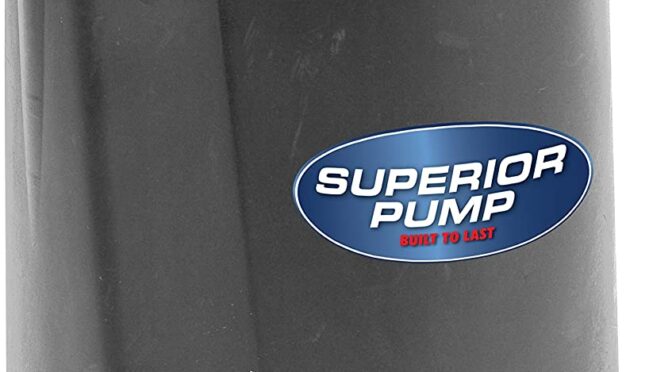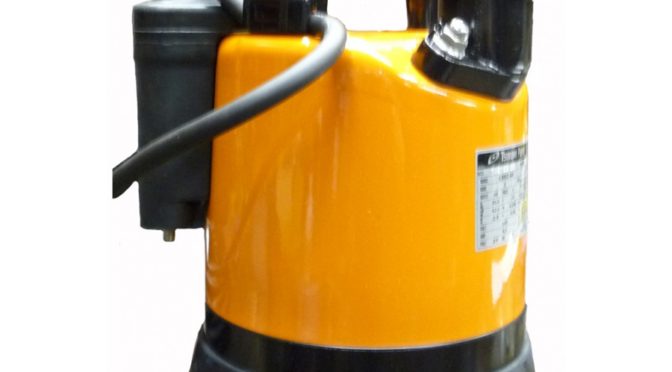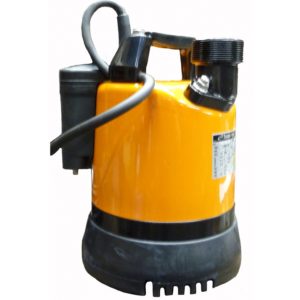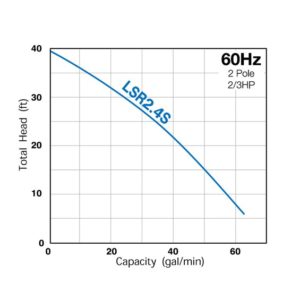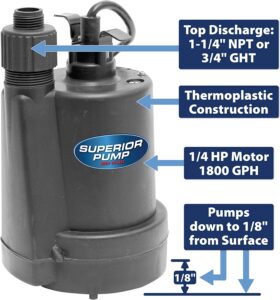 When you’re dealing with a flooded basement or a high water table, you’re going to want a heavy duty sump pump to keep you high and dry, along with a backup pump for water outages. A great example of a main sump pump is the Zoeller M267 while the Wayne ESP25 is a great DC backup system.
When you’re dealing with a flooded basement or a high water table, you’re going to want a heavy duty sump pump to keep you high and dry, along with a backup pump for water outages. A great example of a main sump pump is the Zoeller M267 while the Wayne ESP25 is a great DC backup system.
However, even if you’re set on a main and backup system, you’re still going to want a well-designed submersible utility pump in your tool kit. Trust us; we’ve seen it all. Water has a way of getting in, under, through, and around a hard-earned property. If you don’t take care of it fast, you can find yourself in a whole mess of trouble with property damage, clouds of mosquitoes that make going outside an exercise in punishment, toxic mold, and simply all kinds of other critters that will help themselves to a reliable source of water. Fortunately, you can cut your odds of rotting, floods, breeding insects, asthma-triggering mold, or other physical and medical issues by simply adding a strategically-placed utility pump to your kit. It’s also good for flushing tankless water heaters.
We can’t do much about inflation, but we’re happy to let you know that keeping water from your window wells and roof tops, boat covers and crawl-spaces, and sucking it out of your swimming pools, hot tubs, spas, and laundry tubs can be done without signing away your first born. We’ve looked at a few different submersible pumps over the years, including the Wayne EEAUP250 and the Wayne WWB WaterBug. Today we’re going to take a look at the Superior Pump 91250 1/4 HP Thermoplastic Submersible Utility Pump. It’s got a beast of a name but we’re happy to report that it’s a solid and affordable pump that can clear a decent amount of water with very little fuss. We give our full thoughts below, but if you just want to know if it’s worth buying and where to get it, your answers are yes, and you can buy it here.
Key Features of the Superior Pump 91250 Submersible Utility Pump (60 Second Summary)
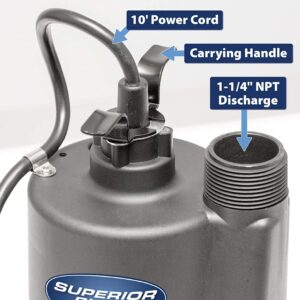 The Superior Pump 91250 is a manual submersible utility pump, or an electric water removal pump. You can use it to do a lot of things, including drain pools or dry out flooded areas indoors or out. It’s fed by a 1/4 HP motor that can pump up to 1,800 gallons of water per hour at zero feet. When immersed at 10 feet, the max flow rate drops to 1,200 gallons and drops again to 540 GPH at 20 feet. The maximum pumping height is 25 feet. It can remove water down to 1/8th of an inch in depth.
The Superior Pump 91250 is a manual submersible utility pump, or an electric water removal pump. You can use it to do a lot of things, including drain pools or dry out flooded areas indoors or out. It’s fed by a 1/4 HP motor that can pump up to 1,800 gallons of water per hour at zero feet. When immersed at 10 feet, the max flow rate drops to 1,200 gallons and drops again to 540 GPH at 20 feet. The maximum pumping height is 25 feet. It can remove water down to 1/8th of an inch in depth.
The 91250 is fully submersible and includes a couple of discharge hookup options; you have a standard 1-1/4 inch NPT discharge as well as a 3/4 inch garden hose adapter. Neither a garden hose nor a discharge hose are included, and there is only one discharge, and it comes out the top. You’re dealing with a manual pump, so you’re going to need to start and stop it on your own; there is no automatic on/off functionality. It’s also important to note that it is water cooled; if you use it to clear a pool and the pool runs dry, it’s going to temporarily overheat and need some rest to cool down. This is pretty standard among budget pumps, so don’t worry about that. The pump includes a suction screen at the base and will sit nicely over a standard 6-inch drain. It weighs just under 7 pounds, is 12 inches tall and 7 inches in diameter at the base, and comes with a 1 year warranty.
How Does the Superior Pump 91250 Submersible Compare to the Wayne WWB WaterBug, Wayne EEAUP250, and Zoeller 42-0007 N42 Utility Pumps?
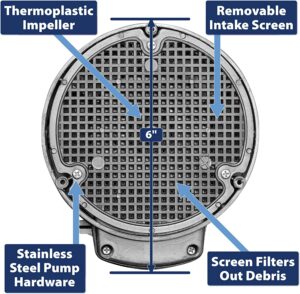 Things we like about the Superior Pump 91250 compared to its competitors include the 1/4 HP motor, much as that in the EEAUP250 and a step above the 1/6 HP motors found in the Zoeller and in the WaterBug. It’s much faster than both the WaterBug, which tops out at 1,257 GPH, and the Zoeller, which is only half as fast at 900 GPH, but it is still beaten by far by the EEAUP250 which clocks in at 3,000 GPH. It’s also worth noting that while the Zoeller and WaterBug are manual pumps like the Superior Pump, the EEAUP250 is an automatic pump.
Things we like about the Superior Pump 91250 compared to its competitors include the 1/4 HP motor, much as that in the EEAUP250 and a step above the 1/6 HP motors found in the Zoeller and in the WaterBug. It’s much faster than both the WaterBug, which tops out at 1,257 GPH, and the Zoeller, which is only half as fast at 900 GPH, but it is still beaten by far by the EEAUP250 which clocks in at 3,000 GPH. It’s also worth noting that while the Zoeller and WaterBug are manual pumps like the Superior Pump, the EEAUP250 is an automatic pump.
The max head is the second-best in the bunch, topping out at 25 feet. The only pump to exceed it here is the WaterBug, which can pump up to 30 feet in height. The Zoeller tops out at 19 feet and the EEAUP250 is the worst of the bunch at 15 feet. The relatively high max head figure means that you can install the Superior Pump in deeper water environments, such as in short wells or in deep sump pump pits; you’ll definitely be able to reach the bottom of any home or recreational swimming pool, and you’ll still be able to pump water. The minimum clearance depth at 1/8th of an inch is mid-range compared to its neighbors; the Zoeller is also 2/16th of an inch and the EEAUP250 falls behind at 6/16th of an inch but the WaterBug pulls ever so slightly ahead at 1/16th of an inch. A more noticeable difference where the WaterBug pulls ahead is in its inclusion of both vertical and horizontal discharge nozzles; this makes it significantly easier to route your draining hose away from the water source.
Our Short and Long Term Experiences Installing and Using the Superior Pump 91250 Submersible Utility Pump
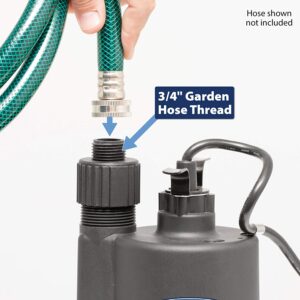 Installation of the Superior Pump 91250 is pretty standard as far as manual submersible pumps goes and frankly speaking, about as easy as it gets in plumping: plug it in with the 10 foot power cord, connect it to a garden hose or other drain hose through the only available discharge outlet (the vertical one), and drop it (well, place it gently) into your flood zone.
Installation of the Superior Pump 91250 is pretty standard as far as manual submersible pumps goes and frankly speaking, about as easy as it gets in plumping: plug it in with the 10 foot power cord, connect it to a garden hose or other drain hose through the only available discharge outlet (the vertical one), and drop it (well, place it gently) into your flood zone.
We’re not a fan of 1 year warranties even at this price point; we feel companies who design tools for use in water need at least 2 years of warranty service standard. However, you’re likely to get up to 5 years of regular use from the Superior Pump as long as you remember to treat it the way you need to treat all manual submersible pumps: either you stay by it when it’s running and turn it off the moment it’s done with water or you spend a few extra bucks to connect it to an automatic float switch (we share recommendations below). When you lose a pump like this early, it’s almost always because you turned it on and walked away, which isn’t good for the motor. That said, this pump typically just turns itself off when it overheats, but you don’t want to make a habit of forcing the pump to self shutdown to protect itself.
Troubleshooting and Installation Tips to Get Your Superior Pump 91250 Submersible Working Sooner
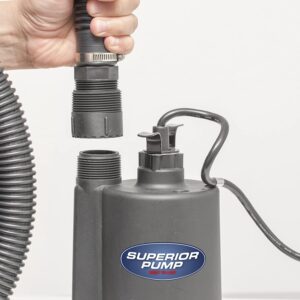 We don’t expect any issues out of the box with the Superior Pump, but the main issue, as we’ve noted above, that you’re likely to face when using it is its penchant to shut off when it overheats. This isn’t a bug; it’s a feature, and it’s a good one, because it’s designed to protect it from damage. If you want to get rid of the risk of premature heat damage while also eliminating the need to babysit your utility pump, you’ll want to buy and attach a utility or sump pump controller, which is an automatic float switch that can turn the pump on and off at predetermined water heights. They’re also known as piggy back switches or dual float switches. When properly installed, they quickly pay for themselves with the time you save no longer needing to turn on and off (or plug in and unplug) the 91250 multiple times a day. Here’s a good example of one you can use with the Superior.
We don’t expect any issues out of the box with the Superior Pump, but the main issue, as we’ve noted above, that you’re likely to face when using it is its penchant to shut off when it overheats. This isn’t a bug; it’s a feature, and it’s a good one, because it’s designed to protect it from damage. If you want to get rid of the risk of premature heat damage while also eliminating the need to babysit your utility pump, you’ll want to buy and attach a utility or sump pump controller, which is an automatic float switch that can turn the pump on and off at predetermined water heights. They’re also known as piggy back switches or dual float switches. When properly installed, they quickly pay for themselves with the time you save no longer needing to turn on and off (or plug in and unplug) the 91250 multiple times a day. Here’s a good example of one you can use with the Superior.
Superior Pump 91250 Submersible Utility Pump Pros, Cons, and Value Comparison
Overall, we’re fans of the Superior Pump 91250. It’s cheap, it’s fast, it pumps deep and drains low. If you want to do much better in all of the above areas you’re going to need an industrial-grade utility pump. We wish it had a double nozzle setup to give us greater flexibility when installing it around the yard. Our main recommendation for an accessory would be to pair it with a utility or sump pump controller (an automatic float switch) to turn it into an automatic pump if you don’t want to need to be present whenever it’s running.
You can buy the Superior Pump 91250 here on Amazon. You can buy the Wayne WaterBug here. You can buy the Wayne EEAUP250 here. You can buy the Zoeller 42-007 here. You can buy a universal check valve kit here and a discharge hose kit with clamps here. You can buy a quality automatic float switch here.
 If you find our work at PumpThatSump helpful, you can put our relentless reviewing of every pump and fixture on the market to the test by shopping through our links for whatever you need to make your house a home. Despite being self-employed, we promise not to spend it all on health insurance.
If you find our work at PumpThatSump helpful, you can put our relentless reviewing of every pump and fixture on the market to the test by shopping through our links for whatever you need to make your house a home. Despite being self-employed, we promise not to spend it all on health insurance.
